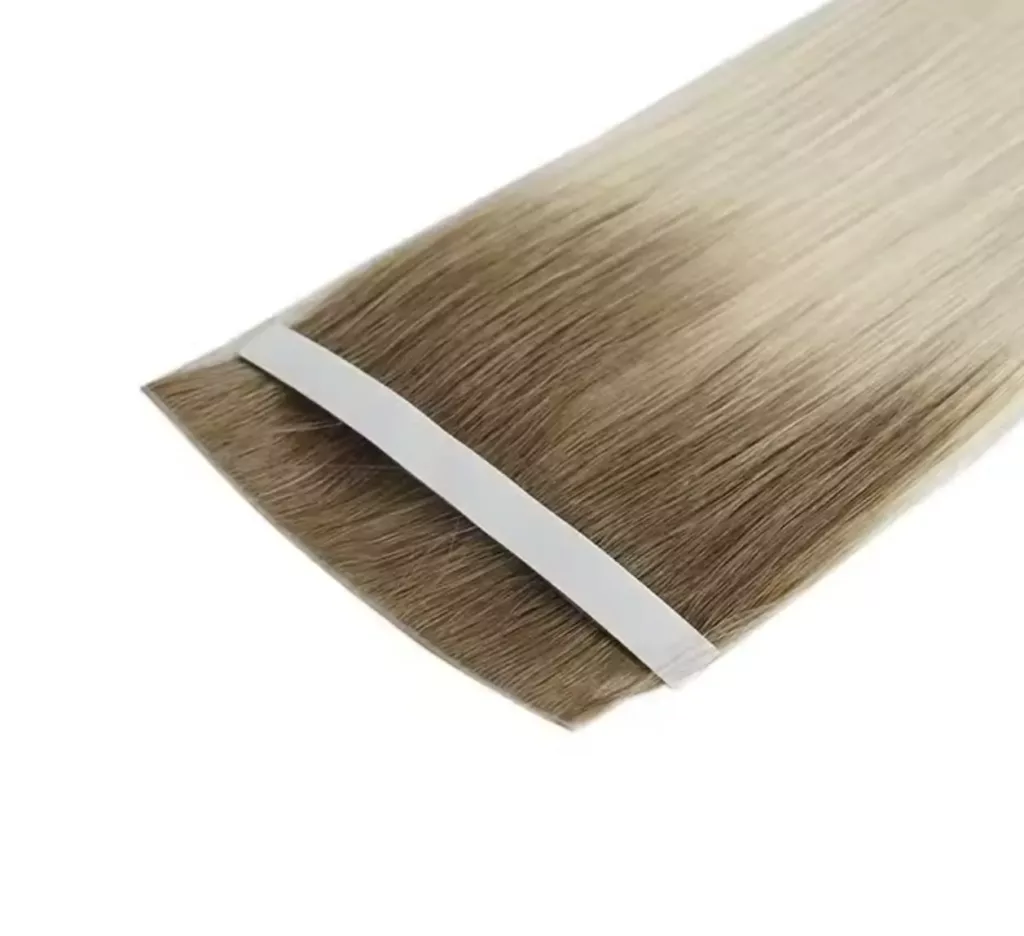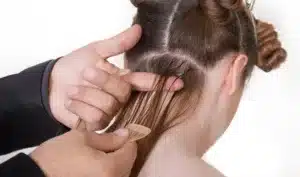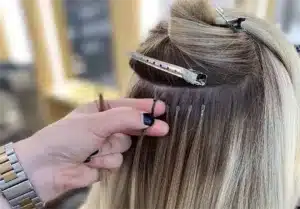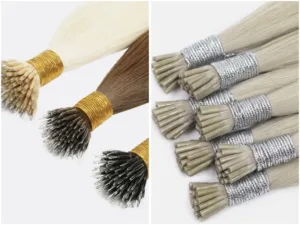When clients ask for discreet, long-lasting extensions, stylists face a key decision—beads or tape? The method U choose affects time, comfort, and reusability.
Tape-in extensions are fast and flat; beaded extensions offer precision and longevity. Both systems work, but each fits different hair types and salon models.

Keep reading to explore how each method compares—from install to maintenance—so U can choose the better fit for your business or clientele.
What Are Tape-In Extensions?
Clients want instant volume. Tape-in extensions deliver that without bulk or braids.
Tape-in extensions are pre-taped wefts applied using a sandwich technique, securing natural hair between two sticky strips.

Dive Deeper: Types, Install, Pros, and Cons
Types of Tape-In Hair
| Type | Description |
|---|---|
| Classic Tape | Most common, flexible adhesive-backed strips |
| Invisible Tape | Hair-injected for scalp-like finish |
| Wide Tape weft | Broader tape tabs for fewer sections |
Installation Steps
- Clean the hair
Wash with clarifying shampoo. No conditioner. Blow dry completely. - Section horizontally
Use thin, even slices of hair. Ensure it’s not too thick or tapes won’t seal. - Apply bottom tape
Place the first tape underneath a slice of natural hair. - Apply top tape
Press second tape above, sealing like a sandwich. - Press and blend
Firm pressure ensures hold. Flat iron (optional) for extra grip.
Pros of Tape-In Extensions
- Quick installation (45–60 minutes)
- Lay flat and blend easily
- Comfortable to wear
- Ideal for fine to medium hair
- Cost-effective for stylists and clients
What Are the Cons of Tape-In Extensions?
- Not suitable for very oily scalps
- Adhesive can weaken if not applied cleanly
- Requires regular move-up (every 6–8 weeks)
- Tapes must be replaced after 2–3 uses
- Limited styling freedom near roots
What Are Beaded Extensions?
Beads allow strand-by-strand precision or track-based installs. No glue. No heat.
Beaded extensions involve securing hair strands or wefts with small metal or silicone-lined beads that clamp onto natural hair.
Dive Deeper: Types, Install, Pros, and Cons
Types of Beaded Extensions
| Type | Description |
|---|---|
| I-Tip Extensions | Individual strands tipped with keratin, inserted into beads |
| Nano Ring Hair | Smaller version of I-tip; ultra-discreet |
| Beaded Weft Extensions | Wefts secured to a beaded foundation row |
Installation Steps
1. For I-Tip and Nano Ring Hair
- Prepare section
Take a small piece of natural hair. - Insert bead
Slide bead near the root using a pulling loop or hook. - Insert extension tip
Place I-tip or nano tip into bead. - Clamp bead
Use pliers to flatten bead securely.
2. For Beaded Weft Extensions
- Create anchor row
Use beads to create a base across the scalp. - Lay the weft
Place the weft on the beaded base. - Secure with thread or bead stitch
Sew or bead across to fix the weft.
Advantages of Beaded Extensions
- No glue, no tape, no heat
- Easier to reposition or adjust
- Great for thick, coarse, or oily hair
- High reusability (can last 6–12 months)
- Very secure with less slippage
What Are the Cons of Bead Extensions?
- Install time is longer than tape-ins
- Risk of bead slipping if poorly clamped
- Not ideal for very thin or fragile hair
- Beads may feel bulky if not blended properly
- Some scalp tension if beads are placed too tightly
Hair Extensions Beads vs Tape
Let’s compare beads vs tape-in extensions across all practical categories. This helps stylists or wholesalers choose what to stock or recommend.
Dive Deeper: Full Comparison Chart
| Feature | Tape-In Extensions | Beaded Extensions |
|---|---|---|
| Application | Sandwich two tape pieces over natural hair | Clamp strands or wefts using beads |
| Installation Time | 45–60 minutes | 1.5–3 hours depending on method |
| Maintenance | Move-up every 6–8 weeks | Tighten every 6–10 weeks |
| Cost | Lower upfront cost; ongoing tape replacements | Higher install cost, but more reusable |
| Pros | Quick, flat, discreet | Glue-free, versatile, longer wear |
| Cons | Limited styling near roots, adhesive limits | May cause tension or slip if done poorly |
| Best For | Fine to medium hair clients | Medium to thick hair, oily scalps, reuse-minded |
U can also blend both systems. For example, use tape-ins at the crown and I-tips near the nape for volume without visibility.

Are Beaded or Tape-In Extensions Better?
There’s no single answer. It depends on the hair type, the client’s budget, and the salon workflow.
Tape-ins win for speed and comfort. Beads win for precision, no glue, and extended reusability.
Dive Deeper: Decision-Making Guide
- Choose tape-ins
When U want fast application, flat results, and work with fine hair. - Choose bead extensions
When U prioritize longevity, offer strand-by-strand installs, or serve clients with oily or sensitive scalps.
Stylists should also consider their own skill level. Tape-ins are easier to learn. Beaded methods demand more precision and experience.
My Opinion
From a factory perspective, both methods have strong markets. Tape-ins move faster online due to lower skill barriers. Beaded extensions, especially nano ring or I-tip, are favored by elite stylists who serve repeat clients.
At Hibiscus Hair, we produce both systems using 100% full cuticle human hair. Our I-tip and tape-in lines are reusable, soft, and consistent—perfect for brands who value quality and longevity.
FAQ
1. Can tape-ins and bead extensions be reused?
Yes. With full cuticle hair, both can be reused multiple times.
2. Which method is better for oily hair?
Beads. Tape may slip if the scalp is oily.
3. How often should I adjust beaded extensions?
Every 6–10 weeks based on hair growth.
4. Do tape-ins damage hair?
Not if installed and removed correctly. Always use professional tape.
5. Are nano rings better than I-tip?
Nano rings are smaller and more discreet but harder to install.
6. Do I need heat for either method?
No. Both systems are heat-free when installed properly.
7. Can I sleep with tape-ins or beads?
Yes. Tie hair in a low braid or ponytail.
8. Which one costs more over time?
Tape-ins cost more in tape replacement. Beads have higher install cost but last longer.
9. Can both methods be combined?
Yes. Many stylists blend techniques for customized installs.
10. Which works better in hot climates?
Beads. Sweat and oil affect tape adhesive more.
Conclusion
Beads offer precision and durability. Tape-ins offer speed and flexibility. Know your client, know your method—and offer both if U can.
Hibiscus Hair Manufacturer has been dedicated to producing high-quality hair extensions for 25 years and is a recognized leader in the industry. If you are interested in finding a reliable hair extensions supplier and wholesale for your brand, please visit our website for more information:
HAIR WEFT
KERATIN HAIR
TAPE IN HAIR




